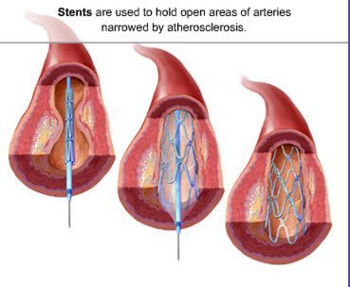Percutaneous transluminal coronary angioplasty: Difference between revisions
imported>Robert Badgett No edit summary |
imported>Robert Badgett |
||
| Line 8: | Line 8: | ||
[[Stent]]ing reduces the rate of restenosis, but should not be done if the patient cannot take [[clopidogrel]], has extensive stenoses, the stenosis is in a very small coronary artery, or if bypass surgery is planned within a few days.<ref name="pmid17202455"/> | [[Stent]]ing reduces the rate of restenosis, but should not be done if the patient cannot take [[clopidogrel]], has extensive stenoses, the stenosis is in a very small coronary artery, or if bypass surgery is planned within a few days.<ref name="pmid17202455"/> | ||
{{Image|Coronary stent.jpg|right|350px|Insertion of the stent on the delivery catheter, expansion of the stent, and lastly appearance after withdrawal of the delivery catheter.}} | |||
==Complications== | ==Complications== | ||
Revision as of 11:11, 27 May 2009
In medicine, percutaneous transluminal coronary angioplasty (PTCA), also called percutaneous coronary intervention (PCI), is a form of myocardial revascularization in which occurs "dilatation of an occluded coronary artery (or arteries) by means of a balloon catheter to restore myocardial blood supply."[1]
PTCA may be a treatment for myocardial infarction and an intravascular stent may or may not be left at the site of the stenosis in order to prevent restenosis.[2]
Stenting
Stenting reduces the rate of restenosis, but should not be done if the patient cannot take clopidogrel, has extensive stenoses, the stenosis is in a very small coronary artery, or if bypass surgery is planned within a few days.[2]
Complications
Ventricular dysrhythmia during PTCA for myocardial infarction indicates an increased risk for mortality at 3 months.[3]
References
- ↑ Anonymous (2025), Percutaneous transluminal coronary angioplasty (English). Medical Subject Headings. U.S. National Library of Medicine.
- ↑ 2.0 2.1 Keeley EC, Hillis LD (2007). "Primary PCI for myocardial infarction with ST-segment elevation". N. Engl. J. Med. 356 (1): 47-54. DOI:10.1056/NEJMct063503. PMID 17202455. Research Blogging.
- ↑ Mehta, Rajendra H.; Aijing Z. Starr, Renato D. Lopes, Judith S. Hochman, Petr Widimsky, Karen S. Pieper, Paul W. Armstrong, Christopher B. Granger, for the APEX AMI Investigators (2009-05-06). "Incidence of and Outcomes Associated With Ventricular Tachycardia or Fibrillation in Patients Undergoing Primary Percutaneous Coronary Intervention". JAMA 301 (17): 1779-1789. DOI:10.1001/jama.2009.600. Retrieved on 2009-05-06. Research Blogging.
